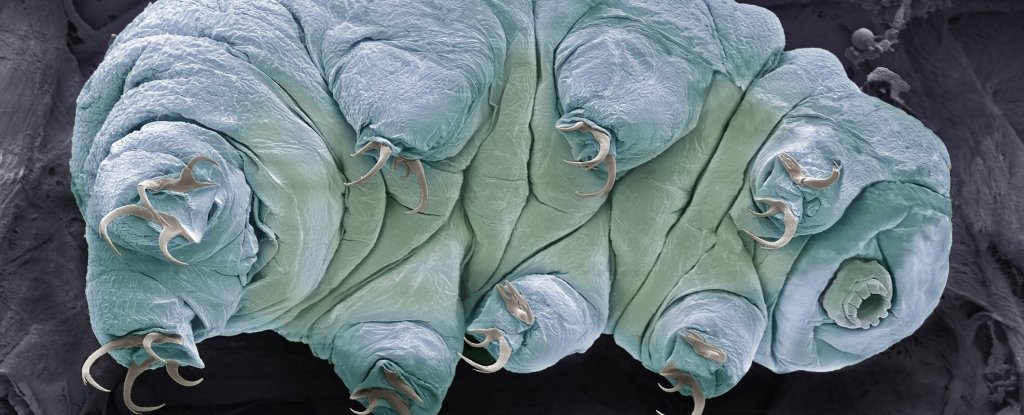Products You May Like
We can now add “being fired out of a gun at high speeds” to the growing list of weird things tardigrades can survive.
How do we know? Scientists actually did it – and, believe it or not, it’s for a good cause. They wanted to know if tardigrade-like organisms could survive certain conditions in space, in order to place constraints on where and how we might be able to find extraterrestrial life in the Solar System – and how we might avoid contaminating it.
Tardigrades, microscopic invertebrates also known as water bears and moss piglets, are globally ubiquitous, found both in terrestrial and water ecosystems pretty much everywhere. That’s hardly a surprise, really: the tiny creatures are able to survive some insane conditions.
When conditions get nasty, they can dry out, reconfigure their bodies and enter suspended animation – called desiccation – for years. You can throw virtually anything at them: frozen temperatures, zero oxygen, high pressures, the vacuum of space, cosmic radiation, and even being boiled.
These so-called “indestructible” beasties made global headlines in 2019, when a spacecraft carrying some crash-landed on the Moon, prompting speculation about the tardigrades’ survival on our satellite.
It certainly raised some interesting questions. How violent an impact can tardigrades survive? The answer would have implications for astrobiology, including the panspermia model, which proposes life can be distributed throughout the cosmos via asteroids and comets that crash into planets.
It can also tell us how likely tardigrades are to survive in places like the Moon or the Martian moon Phobos, which could have been impacted by ejecta from Earth and Mars respectively, potentially carrying microscopic life.
Finally, it can help us gauge the survival rate of tardigrade-like organisms in the saltwater plumes ejected from icy ocean worlds like Europa and Enceladus.
So, astrochemist Alejandra Traspas and astrophysicist Mark Burchell, both of the University of Kent in the UK, designed an experiment to find out.
Burchell specializes in hypervelocity impacts, and his department has a two-stage light-gas gun, which uses a two-step process to accelerate projectiles. First gunpowder, then a light gas such as hydrogen or helium placed under rapid pressurization, are used to achieve velocities up to 8 kilometers (5 miles) per second.
The researchers loaded two or three individuals of Hypsibius dujardini, a species of freshwater tardigrade, each into a number of nylon sabots, which were frozen to induce the creatures’ hibernation state, known as tun.
These sabots were then loaded into the gun, and fired at sand targets in a vacuum chamber at a range of velocities from 0.556 to 1.00 kilometers per second.
The sand target was then poured into a water column to isolate the tardigrades, which were separated and observed to determine how long it took them to revive from the tun state. As a control, 20 tardigrades were frozen and not shot out of a gun.
All of the control tardigrades recovered after about 8 or 9 hours. The impacted tardigrades survived up to and including an impact velocity of 825 meters per second; but they took longer to recover, suggesting internal damage. The next highest velocity, 901 meters per second, resulted in tardigrade jam. (That’s still higher than many handgun muzzle velocities.)
“In the shots up to and including 0.825 kilometers per second, intact tardigrades were recovered post shot, but in the higher-speed shots only fragments of tardigrades were recovered,” the researchers wrote in their paper.
“Thus, shortly after the onset of lethality, the tardigrades were also physically broken apart as impact speed increased.”
This suggests that the impact velocity survivability threshold is between these two numbers, equivalent to a shock pressure of 1.14 gigapascals – which places some serious constraints on their impact survivability.
While the study doesn’t directly answer the question on whether the Beresheet tardigrades made it alive after the Moon crash, we do know that the final data received from the spacecraft indicated a vertical velocity 134.3 m/sec and horizontal velocity of 946.7 m/sec.
Some of the material ejected from Earth, kicked up from meteorite impacts, then impacts the Moon within the range of tardigrade survivability. So… it’s possible that tardigrades could survive that voyage.
For Phobos, the scenario is grimmer: material from Mars is estimated to impact Phobos at velocities between 1 and 4.5 kilometers per second; and, in the unlikely event that any tardigrades did survive, harsh solar and cosmic radiation would ensure they didn’t survive long.
For icy moon plumes, the flyby speed of any spacecraft sampling the ejected water would produce high velocities, but that just means we might need to get creative. The shock pressures generated thereby could be mitigated by an aerogel collector or using an orbiter to reduce the relative velocities of the spacecraft and the plumes, the researchers suggest.
“That complex structures undergo damage in shock events is not a surprise,” the researchers wrote. “The peculiarity here may be that recovery and survival is still possible until just before the impact events begin to break the tardigrades apart.”
They suggest that future research perform ongoing observations of the tardigrades, to determine how being fired out of a gun affects their long-term survival.
The research has been published in Astrobiology.
H/T: Science Magazine
